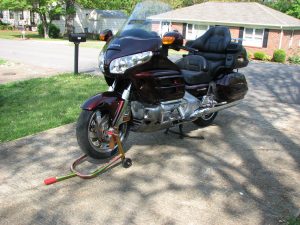 If you’re reading this, you might have recently realized that you have a need for a front stand. There’s a lot of options out there, and in this post we’ll focus primarily on the different types of front stands and why you might prefer one over the other.
If you’re reading this, you might have recently realized that you have a need for a front stand. There’s a lot of options out there, and in this post we’ll focus primarily on the different types of front stands and why you might prefer one over the other.
The most common type of front stand is the Forklift motorcycle stand. This stand will lift under the forks of most bikes. There’s two primary styles of capturing the forks.
- Pegs-into-bottom: This type of stand will lift directly under the forks with a peg that goes into the hole found on the bottom of most forks. This style is more common on lower end stands. The pro is that there is a peg in a hole, so it’s a little bit harder to knock a bike off the stand. The cons are that it does not adapt to uneven forks well, does not work well with some forks, and of course there’s usually a threaded bolt down there that the peg is resting on(read: thread damage)
- Pegs-to-cradle-forks: This type of stand will cradle the forks with one peg under the fork leg and one peg behind the fork leg to support. This type of lift has become increasingly popular since being pioneered by Pit Bull back in 1997. The pros are that it can rotate a bit to accommodate uneven forks legs(there’s even one with independent height adjustment nowadays); it generally features rubber covers to prevent metal-on-metal contact; and of course the swivels are removable if you happen to need a custom or ABS-friendly setup.
The Forklift Motorcycle Stand is going to be great for quickly lifting your(or your friend’s) bike to change a tire, clean the wheel, or simply for storage.
 The second most common type of front stand is the Steering Stem Lift. This stand will lift from the hole in the lower triple tree of most modern sport, standard, and dual-sport bikes. There’s a wide variety of stands to choose from, and here are some key features to look for:
The second most common type of front stand is the Steering Stem Lift. This stand will lift from the hole in the lower triple tree of most modern sport, standard, and dual-sport bikes. There’s a wide variety of stands to choose from, and here are some key features to look for:
- Does it fit your bike: You would think this goes without saying, but some of these stands actually require you to remove the upper fairing in order to lift the bike. This is often the result of a manufacturer using 4-5 pins to “fit most bikes”, or simply that the stand is poorly designed. Look for a fitting chart or talk to the manufacturer to make sure that the front stand you’re interested in purchasing will work for your bike without modifications.
- Is it height adjustable: This is a useful feature because you can level out your bike with whatever height the rear stand(or center stand) puts the bike at. A level bike is useful during oil changes and at times you’ll appreciate being able to lift the bike to a higher setting in order to drop the forks.
- Can it be converted to lift from the forks: This is a nice feature to have, because some bikes have extremely tight fairing to fender clearances, and you don’t always want to drop down to one knee in order to maneuver the pin into place. Also if a friend comes over and you do not have the right pin for his bike, it’s nice to be able to lift from the forks of his bike.
That’s the short version to help you decide which type of front stand best suits your needs. There’s a variety of options out there, and don’t overlook the “combo” front stands that allow you to lift from either the forks or the steering stem. That’s a handy feature to have. Also, if you have a Ducati Superbike you might not have a hole in the lower triple tree(on Superbikes older than the 1098) and on those models you’ll need to look for a “claw” that’s specifically designed for the Ducati lower triple.
Remember that lifting the front will generally require a bit more muscle than lifting the rear of most bikes, so if you are right at the edge of your available strength you might want to opt for a height adjustment or an extended handle on your front stand. Best of luck in your search!